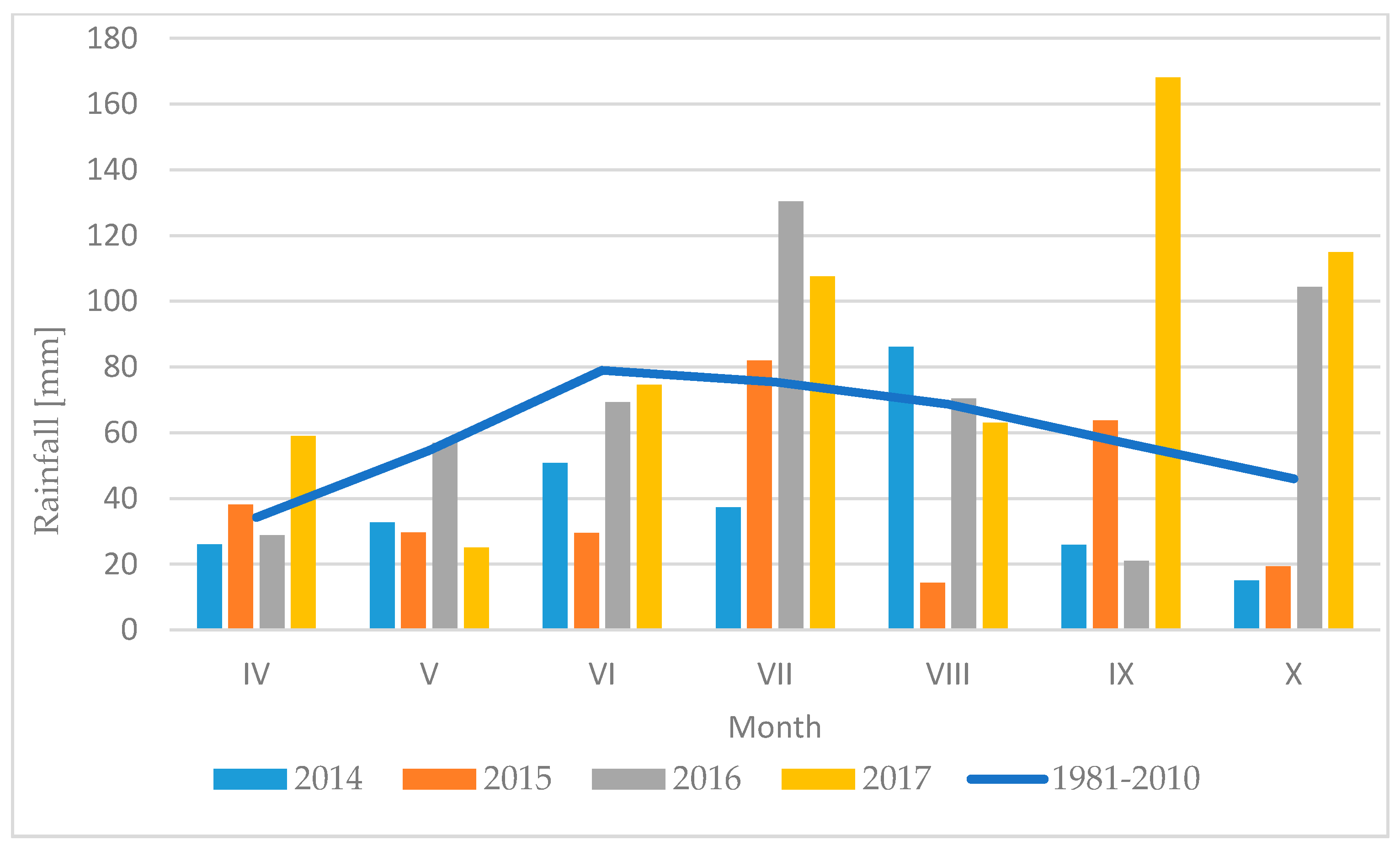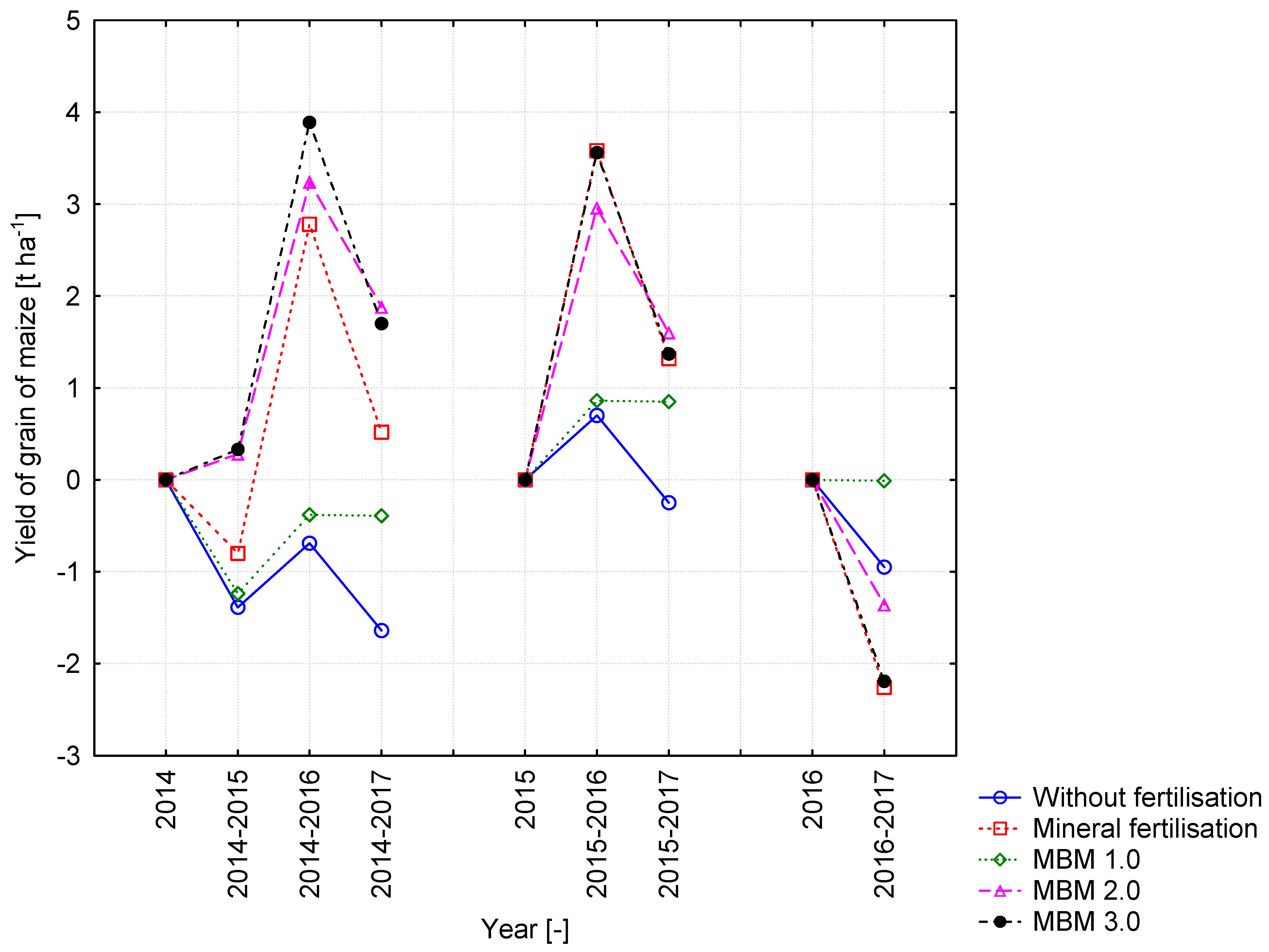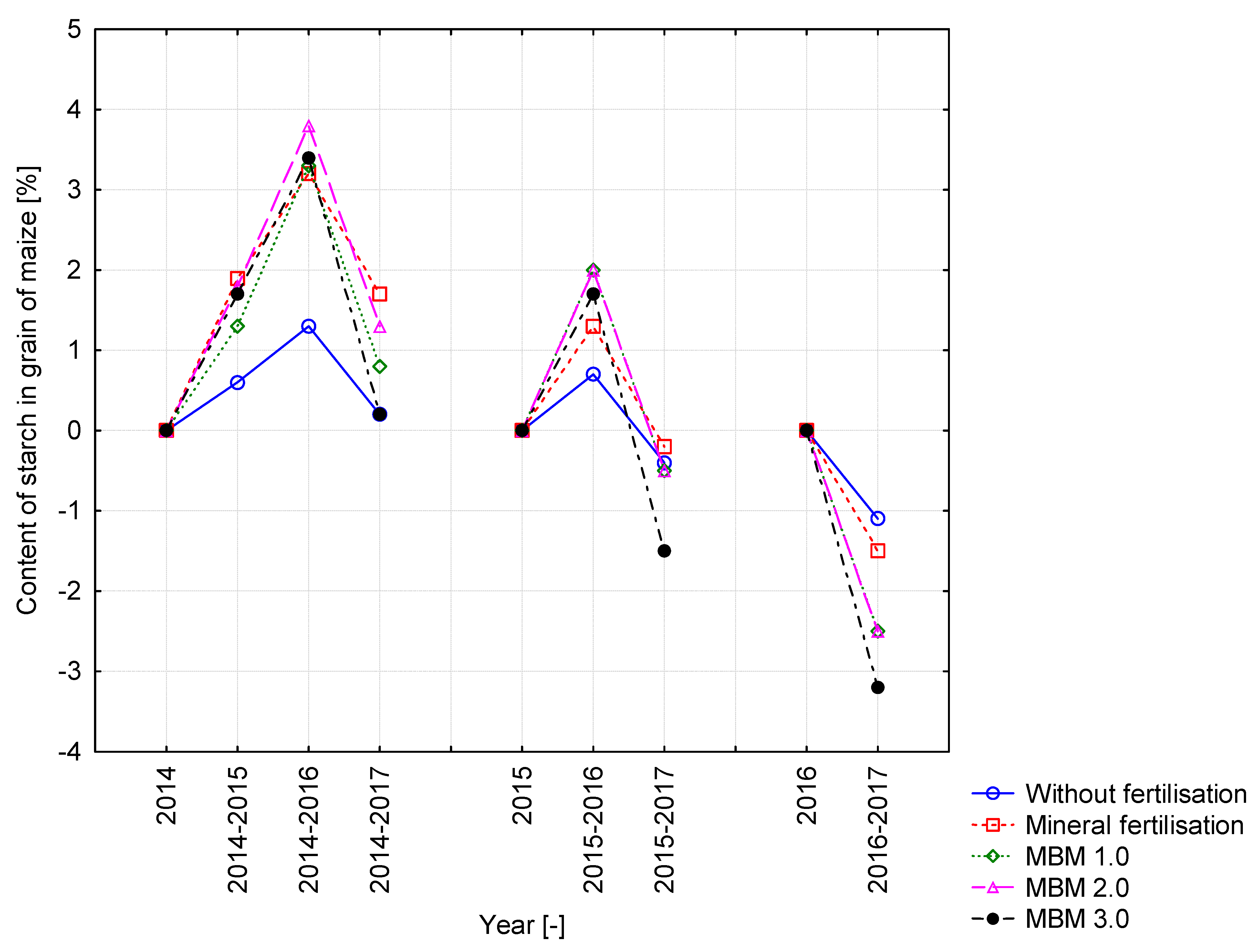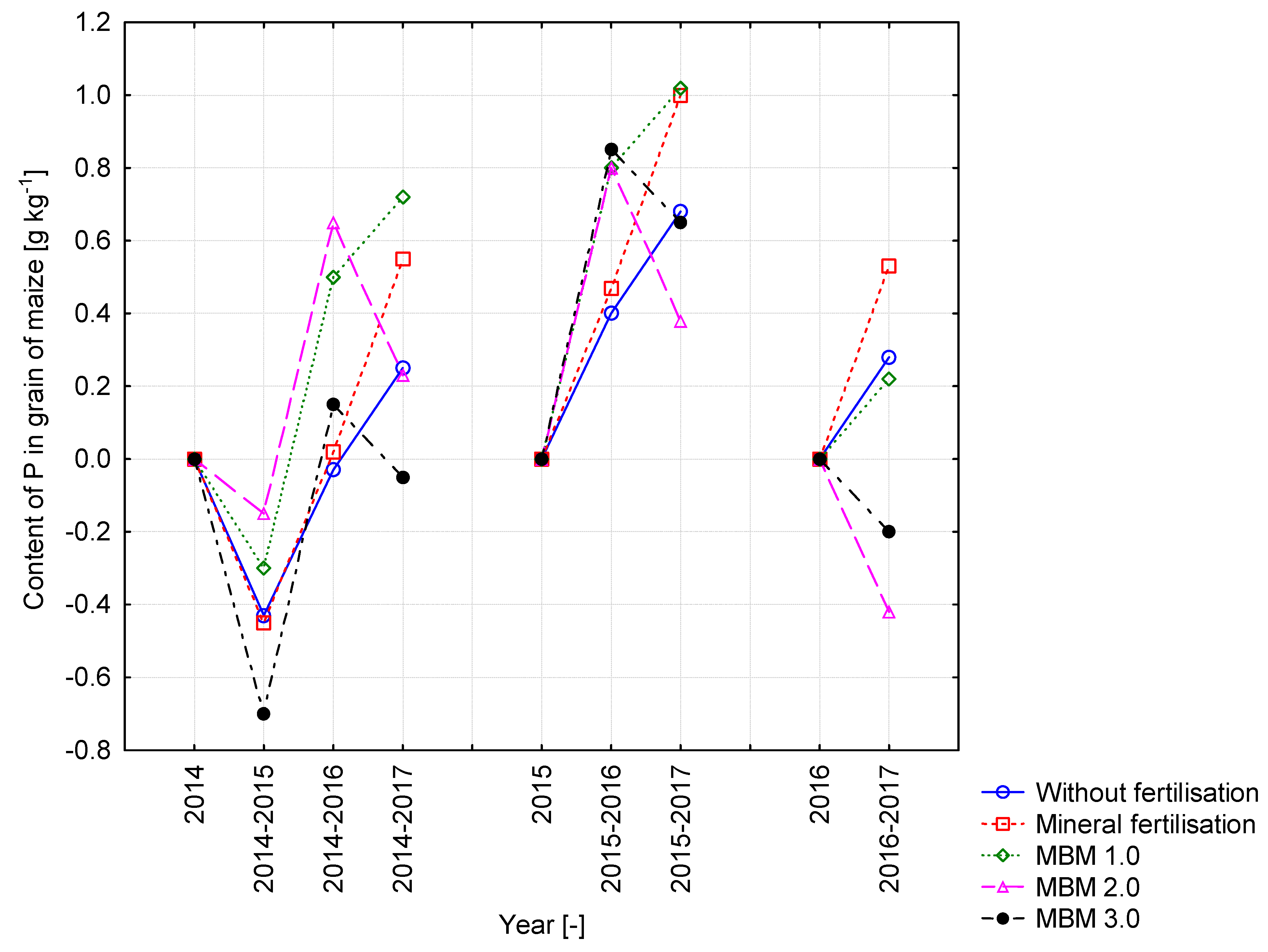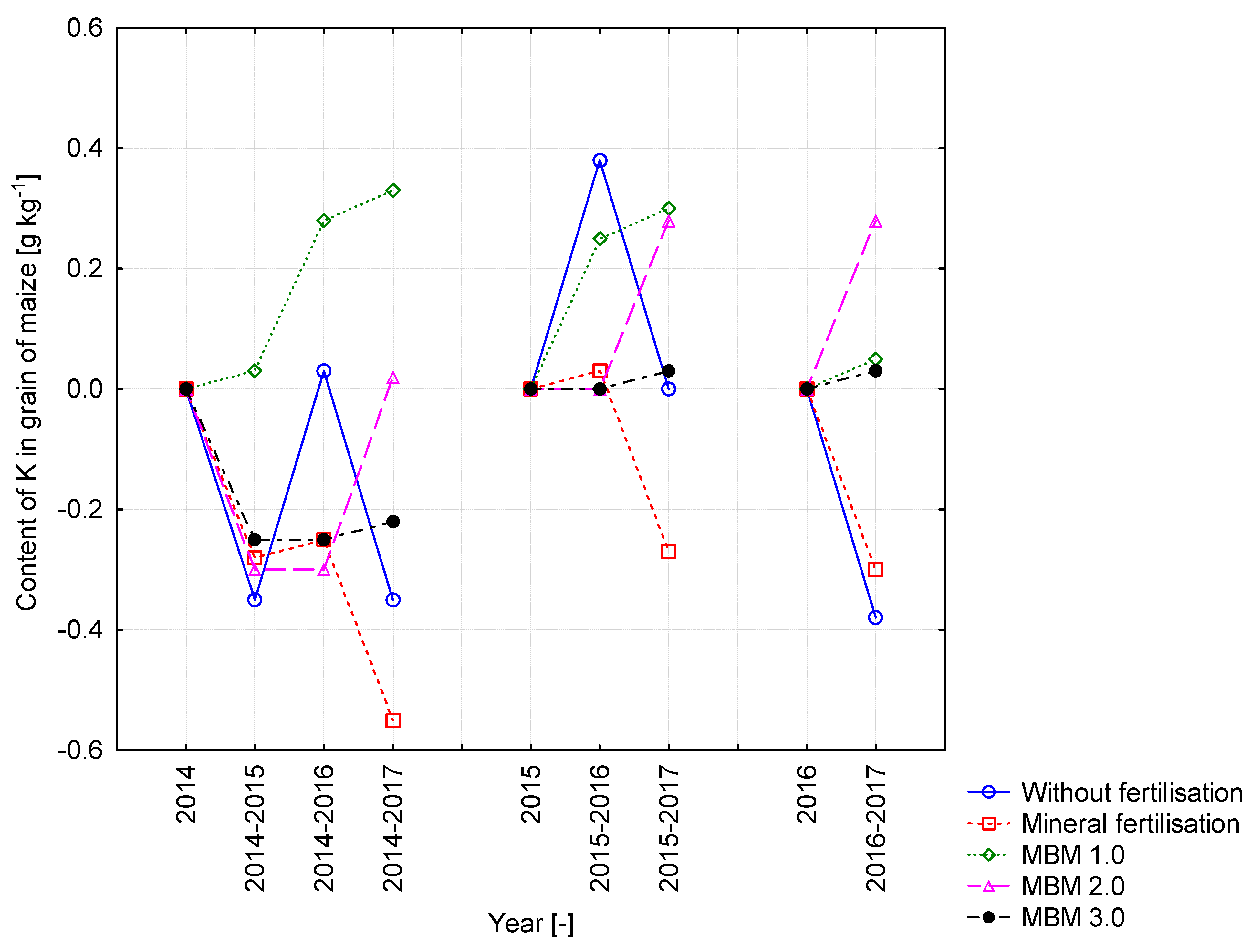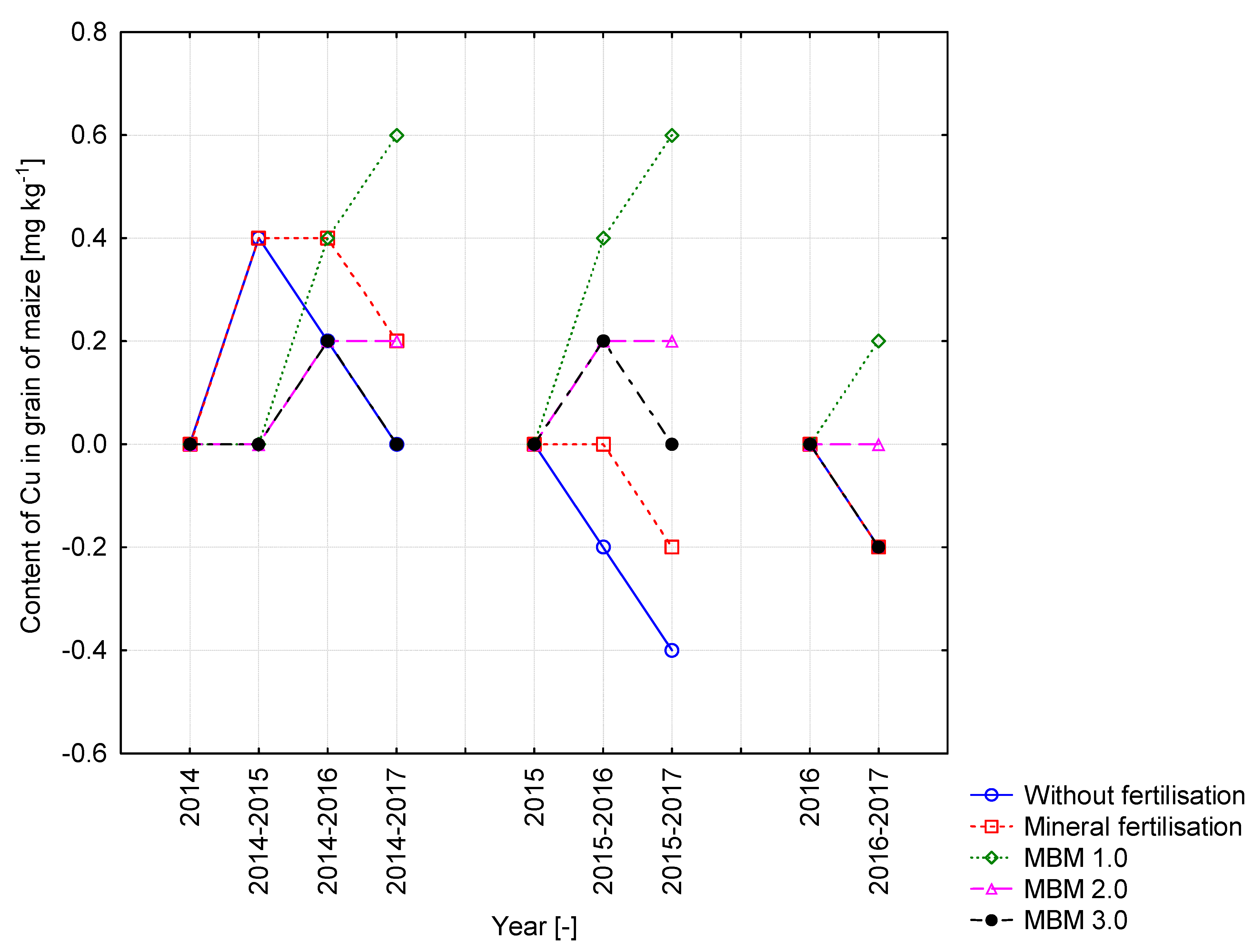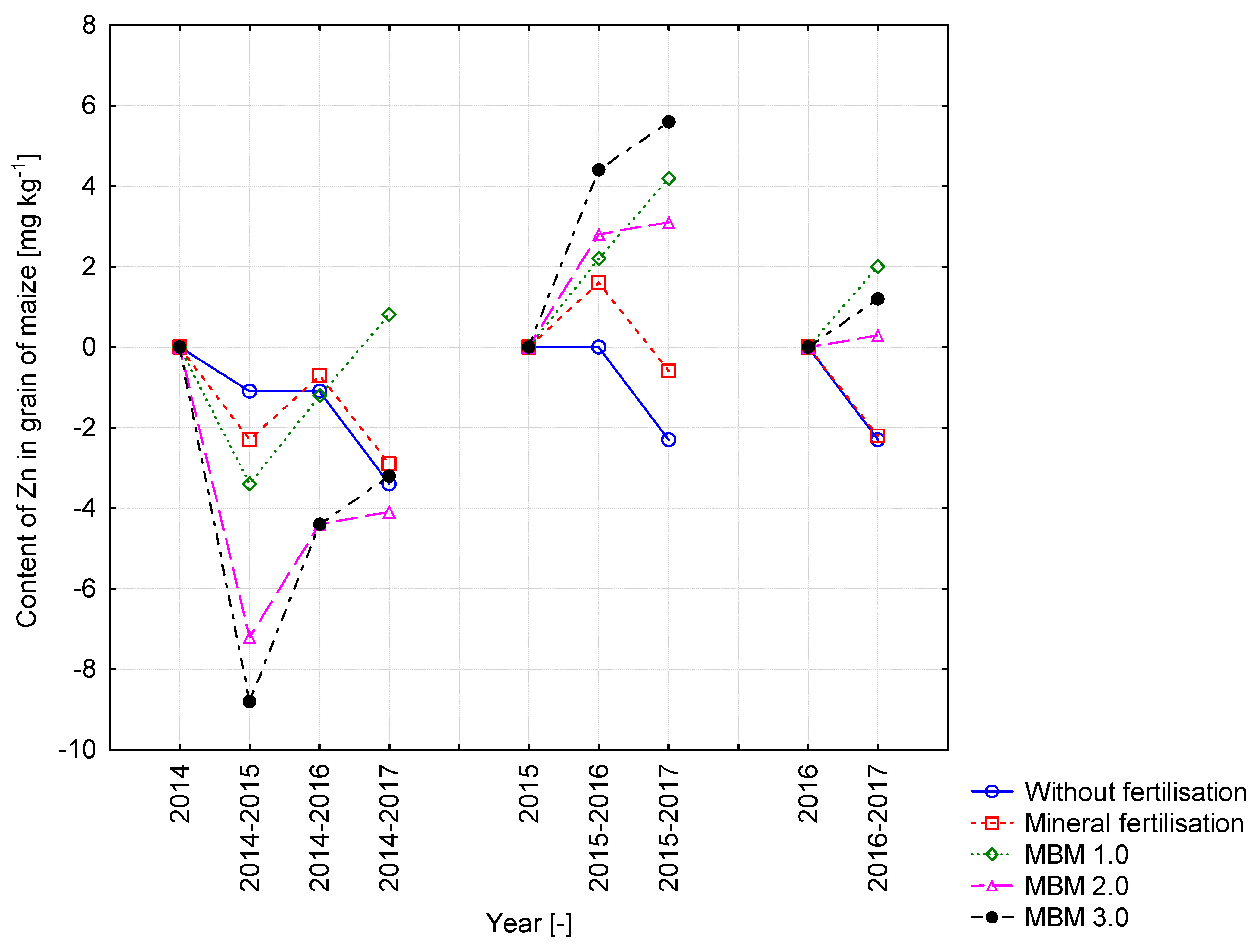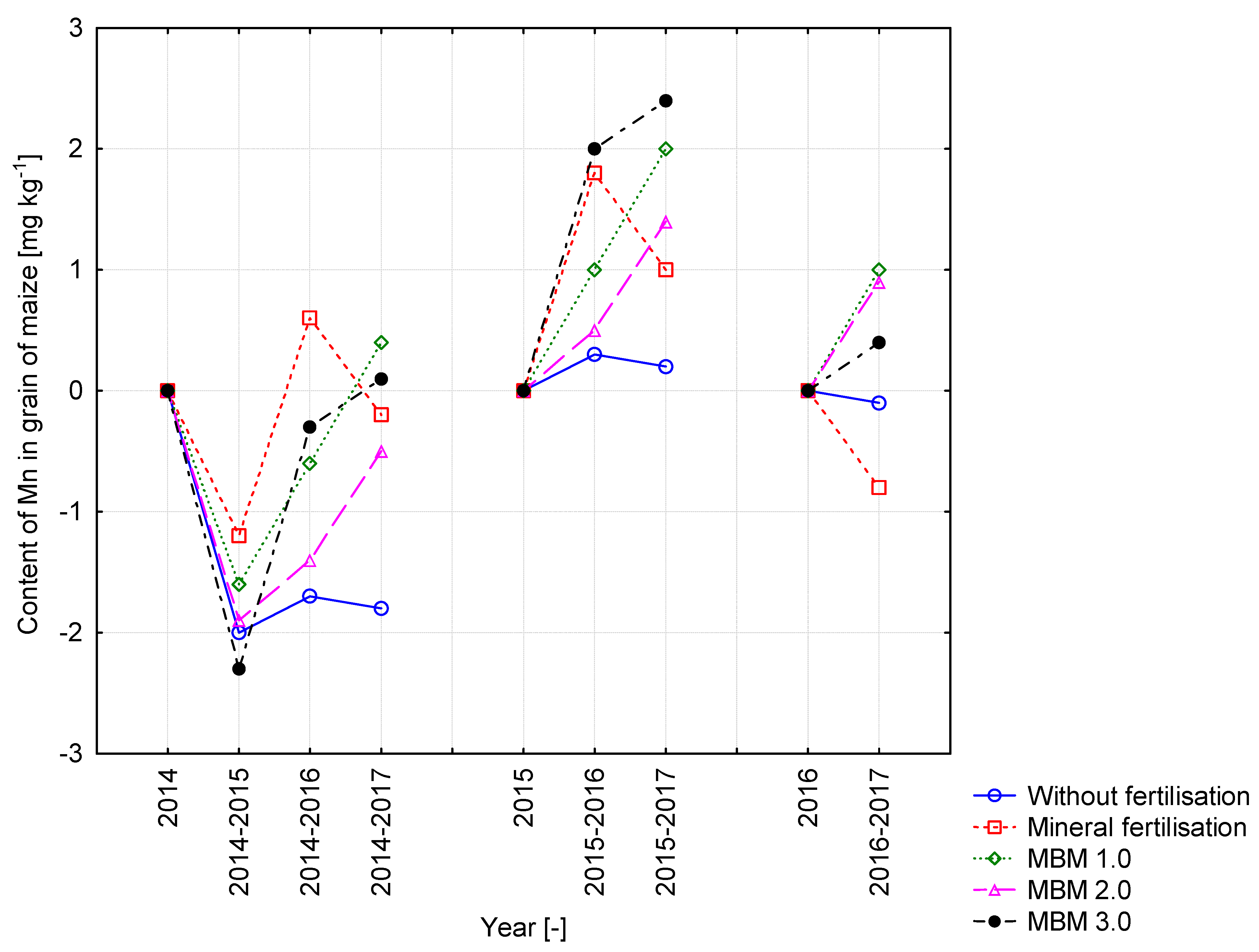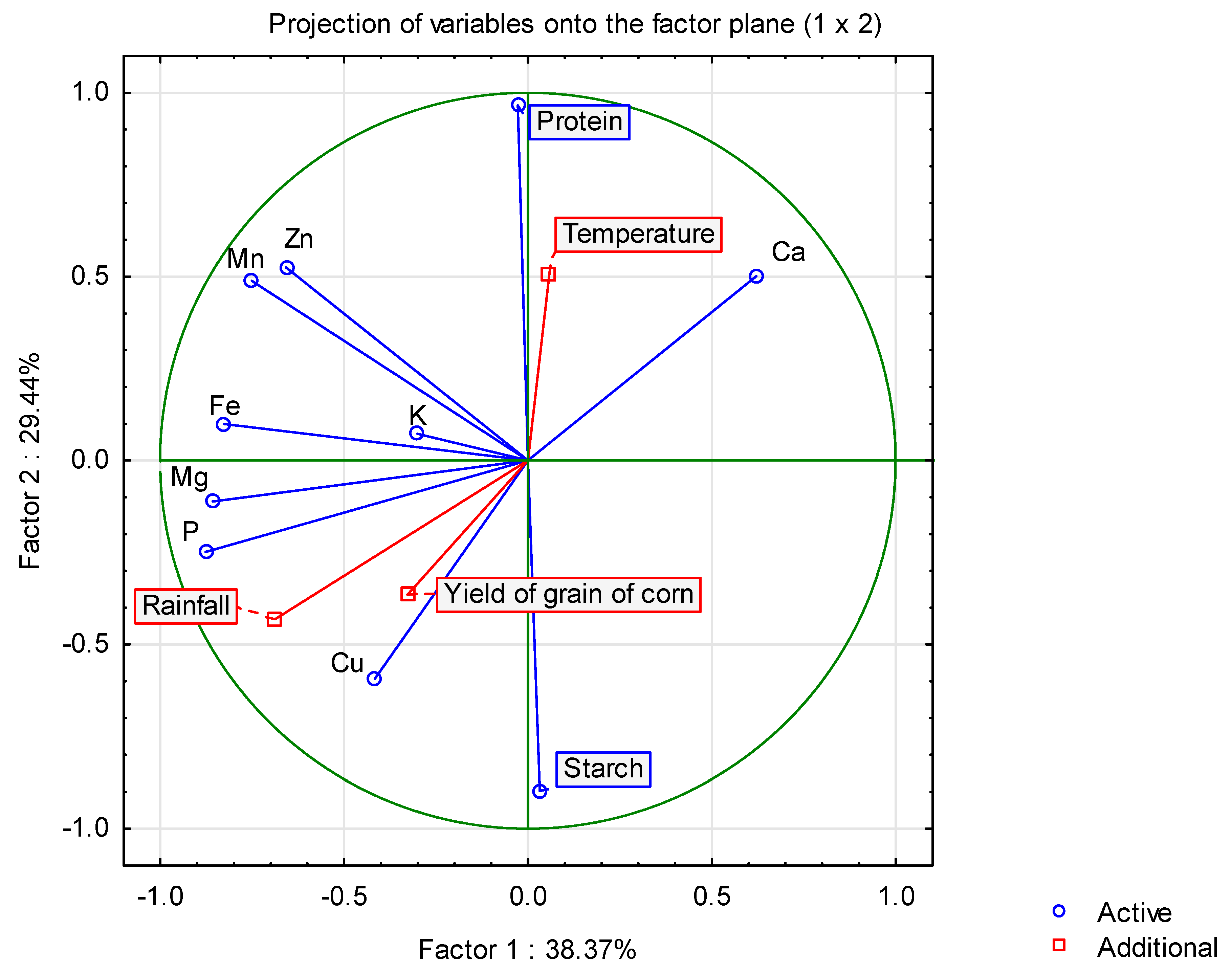1. Introduction
The use of organic waste in agriculture is an important economic, environmental and social factor. Waste, especially biomass, is a large reservoir of materials that can be recovered using various technologies and used for manufacturing different fertilisers [
1]. Waste processed in a controlled manner into the form of animal meat-and-bone meals in rendering plants, for example, poses no hazard to the environment [
2,
3]. The increasing specialisation of agricultural farms and the related reduced production of natural fertilisers (manure) forces farmers to search for alternative sources of organic substances for the purpose of supplying nutrients [
4]. This opportunity is provided by the use of unconventional organic fertilisers, which are the by-products of human activities, including animal meals [
5,
6].
Meat-and-bone meal (MBM) is a by-product of the rendering industry and is considered an excellent potential organic fertiliser due to the balanced availability of nutrients. Animal MBMs are rich in organic substance (50–80%), total nitrogen (67 g kg
−1), phosphorus (40 g kg
−1) and calcium (19 g kg
−1) [
7] and poor in potassium (4 g kg
−1), magnesium (2 g kg
−1), copper (10 mg kg
−1), iron (510 mg kg
−1), manganese (3 mg kg
−1) and zinc (100 mg kg
−1) [
8]. The rather high variability of the chemical composition results, inter alia, from the waste processing and storage technologies applied in rendering plants and from the starting material, i.e., the animal species [
9].
When using MBM in plant production, one notes that the nutrients in MBM are found in a biological form [
10]. Since mineralisation proceeds gradually, the effect of these fertilisers is long term, so that they have a beneficial effect on plants with a long growth and development period, e.g., maize, yet their effect is noticeable only in the years following their application [
11].
The beneficial effect of organic fertilisers results, inter alia, from increasing the soil fertility. Nitrogen provided to crops in the form of MBM is already available in the first year and is able to meet 80% of cereal fertilisation needs for this element [
12]. However, according to Wołoszyk et al. [
13], the total use of nitrogen from organic fertilisers by plants in the first rotation link ranged, on average, from 25.5 to 27.3%, and the consequent effect of organic fertilisation is largely determined by the weather.
Animal MBM can be an efficient plant fertiliser that may replace inorganic fertilisers in providing plant nutrients [
5]. High fertilisation value and the use of MBM in the fertilisation of crops were confirmed by the results of field experiments mainly conducted in Europe [
5,
8,
14]. Scientific knowledge of the efficiency of nutrient use from MBM by maize (Zea mays L.) is incomplete. Maize is a crop with a long growing season that enables the full use of organic fertilisers.
The study aimed to assess the effect of meat-and-bone meal (MBM) and its consequent effect on the yield and quality of maize cultivated for grain.
2. Materials and Methods
2.1. Site and Experimental Set-Up
The study results originate from a controlled, static field experiment established in a random block system in four replications. The experiment using MBM was conducted in the years 2014–2017 at the Experimental Station in Tomaszkowo (53°71′ N, 20°43′ E), Poland. The study involving the annual use of MBM was carried out in a four-year continuous maize cultivation. The area of sowing plots was 15.0 m2, and the harvesting plots covered 11.25 m2. The sowing, cultivation measures and the crop harvest were conducted in accordance with the agrotechnical requirements specific to maize. Weeds were controlled using the herbicide Lumax 537.5 SE at a dose of 4.0 L ha−1 (terbuthylazine 187.5 g L; mesotrione 37.5 g L; metolachlor 312.5 g L). To control pests, seed dressing Mesurol 500 FS at a dose of 1 L per 100 kg grains (methiocarb 500 g L) was used. Since the harmfulness thresholds have not been exceeded, no disease control was conducted.
The top genetic levels in the field under study exhibit the granulometric composition of loamy sand, while the illuvial horizons have a prismatic structure of light loams. The soil was classified as the IIIa class (good arable land). Chemical analyses of the soil at the beginning of the study (2014) were conducted by methods generally accepted for this type of analyses in a certified laboratory of the Chemical and Agricultural Station. The pH was determined potentiometrically in a mixture of soil and 1 M KCl solution (1:5). On all plots, the soil was characterised by a pH of 4.9, an average organic carbon concentration of 10.0 g kg−1 and a concentration of N of 1.00 g kg−1, P of 68.0, K of 128, Mg of 78.0, Cu of 2.39, Fe of 1180, Zn of 6.0 and Mn of 143 (mg kg−1).
2.2. Meat-and-Bone Meal (MBM)
Animal MBM were applied before sowing at doses of 1.0, 2.0 and 3.0 t∙ha
−1 each year. The experimental scheme and the doses of nutrients introduced with MBM are presented in
Table 1. For comparison purposes, plots without fertilisation and with mineral fertilisers (NPK) were introduced. Animal MBM contained small amounts of potassium, which is why it was classified as a nitrogen–phosphorus fertilizer. The MBM used in the study was in the form of powder and classified as category 3, which comprises animal by products derived from manufacture of products intended for human consumption, and it was purchased from the Animal By-Products Disposal Plant SARIA, Poland. Animal MBM contained on average 90% dry matter; 66.9 g C; 61.0 g N; 31.3 g P; 4.0 g K; 48.5 g Ca; 3.0 Mg (g kg
−1 in dry matter); 8.0 Cu, 1189 Fe; 86.5 Zn; 29.0 Mn (mg kg
−1 in dry matter). Along with MBM, potassium in the form of a 49.8% potassium salt was applied to even out the dose to 83.1 kg K ha
−1 (like the one applied on the plot fertilised with mineral fertilisers).
2.3. Grain Yield and Analysis of Elements in Grain
When harvesting maize two outer rows were discarded. Colb was collected by hand and then harvested used a maize combine (Wintersteiger Classic 1540, Austria). The moisture of the grain was measured, and then, the maize grain yields were determined at a humidity of 15%. Grain samples, ground using a laboratory mill (GM 300, Retsch, Germany), were mineralised in H2SO4 with the addition of H2O2 as an oxidising agent to determine macronutrients. Phosphorus concentration was determined by the colorimetric method with vanadium–molybdenium as complexing (UV-1600), Ca and K by atomic emission spectrometry (AES) (Jenway LTD PFP 7, UK) and Mg by AAS. The micronutrient (Cu, Fe, Zn, Mn) concentration in the grains were determined by the flame atomic absorption spectroscopy method using an iCE 3000 SERIES-THERMO atomic absorption spectrometer (Thermo-Scientific, Hemel Hempstead, Hertfordshire, UK) following previous mineralisation in a mixture of acids (65% HNO3 and 70% HClO4) in a 4:1 volumetric ratio.
In grain samples weighing 1.0 kg, protein, fat and starch concentrations were determined using a NIR System Infratec 1241 Analyzer apparatus (Foss, Hillerod, Denmark).
2.4. Statistical Analyses
Data for grain yield and grain protein, fat, starch and nutrient concentrations were analysed statistically using Statistica v.13.1 software. The differences between fertilisation methods were determined using a one-way analysis of variance (ANOVA) and Tukey’s test was applied to identify the homogeneous groups. The calculations were performed at the significance level α = 0.05 [
15]. The dependent variables were corn yield, protein, starch and micro and macro components and, as a qualitative factor, the year of cultivation in particular groups of fertilizer variants used or fertilizer doses used in individual years of maize cultivation.
The analyses concerning the concentrations of selected micro- and macronutrients in maize grain were supplemented by determination of correlations between the aforementioned factors. To achieve this goal, the factor analysis method (PCA) was employed, which enabled the determination of correlation strength and direction between measurement variables [
16]. The after-effect was determined as the difference between: (a) the first (2014) and the second (2015), the third (2016) and the fourth (2017) years of cultivation, (b) the second (2015) and the third (2016) and the fourth (2017) the cultivation years, (c) the third (2016) and fourth (2017) cultivation years.
4. Discussion
Maize is currently the most productive and prospective cereal plant, which makes good use of nutrients from mineral and organic fertilisers [
20,
21]. The amount and quality of the harvested maize grain yield are largely determined by agrotechnical [
22,
23,
24] and agroclimatic factors [
25,
26], with the availability of soil moisture and nitrogen at critical growth stages having relatively large effects [
27,
28].
The yield of maize grains, irrespective of the experimental factors, ranged from 2.95 to 8.34 t ha−1. The lowest grain yield was obtained in 2015 (an average of 4.28 t ha−1), while the highest was in 2016 (an average of 6.61 t ha−1).
Such low yields in 2015 were caused by water shortages in the period of the initial growth of maize (May and June) and high temperatures in August, which combined with low precipitation exacerbated the losses from initial growth period. Consequently, it led to reduced use of nutrients contained in the mineral fertilizer or MBM.
One of the possible ways to minimize the drought impact is to develop plant tolerance by effective management of plant nutrients [
29]. The primary impact of drought on a crop is a reduction in yield as well as the quality of produce, which occurs due to decline in available macro- and micronutrients and associated microbial activities [
30,
31]. Maize cultivated in 2016 was exposed to favourable moisture and temperature conditions and MBM in doses of 2.0 and 3.0 t ha
−1 enhanced the yield of grain as compared with the 1.0 t ha
−1 MBM and no fertilisation treatments.
The provision of optimum conditions for nitrogen nutrition using exclusively organic fertilisers is complex because mineralisation enhanced the yield of grain as compared with the 1.0 t ha
−1 MBM, and no fertilisation treatments coincide with the dynamics of nitrogen uptake by crops [
32]. Therefore, when considering fertilisation with organic fertilisers, including MBM, not only the direct effect but also the consequent effect needs to be taken into account [
4,
8,
33,
34,
35,
36].
In the present study, the effect of 2.0 and 3.0 t ha
−1 MBM treatments and, consequently, the accumulation of nutrient amounts ensure sufficient amounts to obtain high yields (2016 and 2017), which are even higher than those following the mineral fertilisation. However, according to Kivelä [
37] and Kivalä et al. [
38], the supply of nitrogen from MBM for production of sugar beet (
Beta vulgaris L. subsp.
vulgaris) is not sufficient to obtain the same yields as for mineral fertilisers. According to Kivalä [
37], the efficiency of using nitrogen from MBM in the fertilization of sugar beet amounted to 83% compared to that obtained following fertilisation with mineral fertilisers.
Irrespective of the fertilisation, grains had the highest protein concentration and the lowest starch concentration in 2014, the first year of the study. The high temperature that occurred in July 2014 in the grain filling period, combined with available water as compared with other months and years, determined the greater accumulation of nitrogen in the grains. The relationships between the protein concentration in the grains and the temperature are confirmed by studies by Ashraf [
39] and Tomás et al. [
40].
In 2016, following the application of 2.0 and 3.0 t ha
−1 of MBM, the highest grain yields were obtained, as well as low protein concentrations and an increase in the starch concentration in the maize grains, as compared to other years. The relationships between protein and starch can be affected by the interactions between nitrogen and phosphorus [
41]. Moreover, the large supply of phosphorus contributes to an increase in the starch concentration at the expense of protein [
42].
Following the application of MBM at a dose of 3.0 t ha
−1, higher protein concentrations were demonstrated than in other fertilisation variants (with the exception of a similar concentration obtained after NPK fertilisation in 2016). The effect of fertilisation with high MBM doses on the greater accumulation of protein as compared to those fertilised with mineral fertilisers was confirmed by studies by Nogalska et al. [
43], Stępień and Wojtkowiak [
44]. According to Nogalska et al. [
45], the results of study show that the maximum MBM dose (2.5 t ha
−1 year
−1) met the fertilizer requirements of maize with respect to nitrogen.
The maize grains, depending on the fertilisation variants, contained from 0.200 to 0.313 g P kg
−1, from 0.400 to 0.463 g K kg
−1, from 0.105 to 0.140 g Mg kg
−1 and from 0.040 to 0.103 g Ca kg
−1. The macronutrient concentration in the maize grains following the application of MBM was similar to the composition of grains fertilised with mineral fertilisers. Similar effects of the comparable action of MBM with mineral fertilisation on the macronutrient concentration in the maize grains were confirmed by Nogalska [
43].
The P concentration in these organic sources is high, not all P is in soluble form and, thus, is not directly available for plants. Rock phosphates and MBM contain approximately 20–30% P as hydroxyl apatite, the bioavailability of which is low [
46]. According to Chung and Jeong [
47] the effectiveness of powdered bone meal as a phosphorus fertiliser is at least 90%.
The application of 1.0 t ha
−1 MBM in 2016 and 2017 increased the P concentration in relation to the 1st and 2nd year of the study. Jeng et al. [
33], Valenzuela et al. [
48] and Nogalska et al. [
49] claim that the MBM can be regarded as the main source of this component for plants cultivated in subsequent years, due to the low assimilability of phosphorus in the first growing season. The reason for the greater increase in the P concentration in subsequent years following the application of the lowest MBM dose, in relation to higher doses, may have been a lower supply of nitrogen with this meal dose, which failed to increase the yield and the dilution of phosphorus in the grains. In the third year (2016), an increase was demonstrated in the P concentration in the maize grains following the application of higher meal doses, in relation to the previous years. According to Ylivalnio et al. [
10], in the first year following the application of MBM, only 20% of phosphorus is converted into assimilable forms, while after three years, it reaches 60%. On the other hand, according to Jenga et al. [
33], as early as the first year of the introduction of meal, 50% of this component is available.
The potassium accumulation in plants is mostly determined by the weather conditions, the variety and the nitrogen and phosphorus supply [
50,
51,
52]. The applied MBM with supplemented potassium in the form of a mineral fertiliser had no effect on the K and Mg concentrations in the maize grains.
Meat-and-bone meal [
7] and bone meal [
11] may be an alternative to natural, organic and mineral fertilisers as it is rich in calcium but in an amount that is not always sufficient to satisfy plants with this component. The total amount of calcium in MBM originates mainly from the bones, and approx. 99% of it occurs in the bound form as apatites [
2], while the remaining 1% is directly available to plants in the form of (Ca
2+) ions. In the years of the study, no significant differences in the Ca concentration between fertilisation variants or the identical effects of MBM in the accumulation of this element in the grains were demonstrated.
With the MBM, micronutrients are introduced in amounts that are able to satisfy plants with these components [
8,
38]; in the second year of the study (as compared to the first one), a lower micronutrient concentration in the grains was noted. An effect of this process could have been the drought that occurred in 2016, which did not promote the mineralisation of the meal in the soil or the availability of nutrients. Although the mineral concentration in the meal implies a good fertiliser value, the study failed to demonstrate a clearly defined effect of increased MBM doses on the concentration of the analysed element in the maize grains. Higher grain concentrations in subsequent years of the study were demonstrated following the application of a lower dose (1.0 t ha
−1), which may be a result of lower nitrogen availability as a consequence of the lower grain yield and the oversupply of micronutrients [
8].
When assessing MBM, the fact that the release of minerals is spread over years should be taken into account. The effect of the accumulation of higher MBM doses and, consequently, the accumulation of nutrient amounts ensure sufficient amounts to obtain high yields (even higher than those following mineral fertilisation). The nutrients contained in MBM are found in the biological form, while nutrients available for the plant are found only after mineralisation that takes place under optimal soil moisture conditions.

